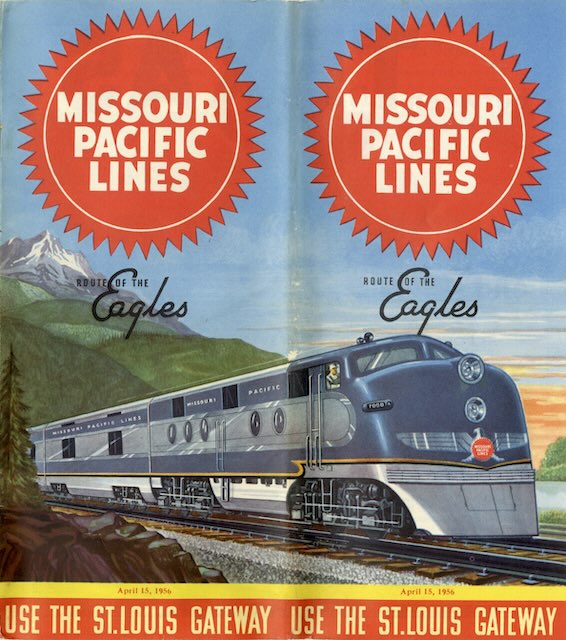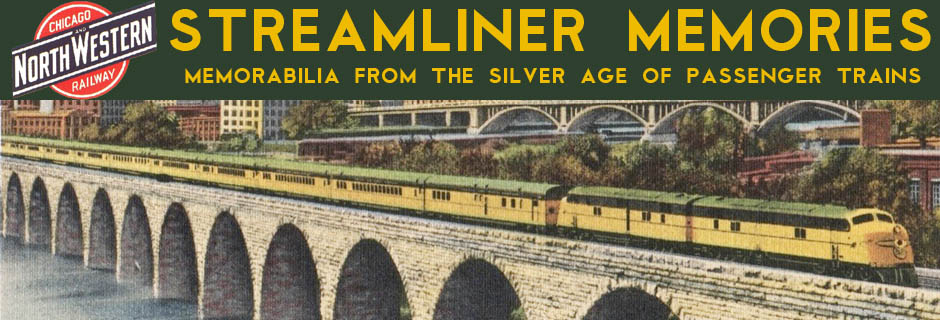Today’s timetable features the battle of San Jacinto on its “historic landmarks” page. For those not familiar with Texas history, this was the battle after the Alamo in which the Texas forces routed the Mexicans and won their independence. This is number 7 in the historic landmark series.
 Click image to download a 25.0-MB PDF of this 48-page timetable.
Click image to download a 25.0-MB PDF of this 48-page timetable.
The page after the centerfold map is the first in a series of state capitol buildings that were featured on MP’s dining car service plates. MP did a service plate featuring state flowers in the steam era; both plates are shown here. On the plate, Missouri’s capitol is giving the top position, but apparently the timetables will present the capitols in alphabetical order as today’s page is for Arkansas.
The inside front cover is another advertisement for the through sleeping car service on GM&O-MP between Chicago and Texas. Oddly, this through-car service isn’t actually shown in any single timetable. The Texas Eagle is shown in condensed tables K and M on panels 9 & 10 and in full tables 17 and 19 on panels 33 through 35. The Chicago connection is shown many pages later on panels 65 and 66, which show four GM&O trains between Chicago and St. Louis but doesn’t identify which one carried the through sleepers. This is a missed opportunity since MP was competing directly against Santa Fe’s Texas Chief.
The Texas Chief left Chicago at 6 pm and arrived in Fort Worth at 12:50 pm the next day (18-1/2 hours) while the Houston section arrived at 7 pm (25 hours). The Abraham Lincoln left Chicago at 11:40 am, arriving in St. Louis at 4:50 pm. The through sleepers then would have left St. Louis at 5:45 pm, with one arriving in Fort Worth at 8:50 am (21-1/6 hours) and the other in Houston at 10:40 am (23 hours). The GM&O-MP route to Houston is faster than the Santa Fe route, and while the Fort Worth route is slower, the MP train also went to Dallas while Santa Fe passengers had to change trains to get to Dallas.
The inside and outside back covers advertise freight services. However, panel 14 introduces something new: a crossword puzzle in which every entry is the name of a station on the Missouri Pacific. The “clues” are the table number and time a Missouri Pacific train is at the station, which makes for a pretty stupid puzzle. Despite the ease of the puzzle, the answers were provided on panel 58.
Panel 18 is a rather surprising announcement that Missouri Pacific has selected a new board of directors that would take over management of the company as it emerged from bankruptcy on March 1. It is surprising to me as I didn’t realize until correspondence with a Streamliner Memories reader that MP had entered into bankruptcy in 1933 and it took nearly 23 years to recover. It is also surprising that it would be so up front about admitting to this in a passenger timetable.
During those years of bankruptcy, Missouri Pacific introduced all of its Eagles streamliners, dome cars, and these magazine-style timetables. Being in bankruptcy meant it didn’t have to make regular payments on its bonds and it didn’t have to pay any dividends to stockholders. But the case could be made that the trustees managing it during those years were rather frivolous in spending extra dollars on these fancy timetables.
Prior to the 1933 bankruptcy, a majority of the stock in MP had been owned by the Van Sweringen brothers, who also owned the Nickel Plate, Erie, Chesapeake and Ohio, and several smaller railroads. Their goal was to build a “fourth” railroad system that could compete in the east with the Pennsylvania, New York Central, and Baltimore & Ohio, but the Interstate Commerce Commission rejected their plan to merge several of their railroads into one. Overleveraged, they went bankrupt, taking the Missouri Pacific with them, in 1933.
Did MP go bankrupt because of too much competition and too little business during the Depression, as it claimed at the time? Or had it had been looted by the Van Sweringens? Unfortunately, I can’t find a definitive history of the railroad, but this was the second time the railroad had entered bankruptcy while under the control of someone with aspirations for creating another transcontinental railroad, the first being in 1915 when it was controlled by George Gould.
